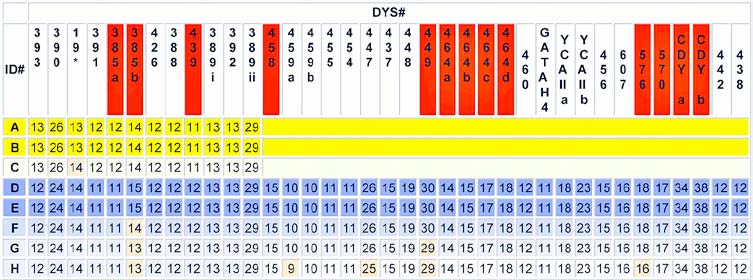A little over a year ago, the Turnbull Clan DNA project was started and we thought this was a good time to give an update to members on the progress and to answer some frequently asked questions about the project and the results.
To date, we have 29 participants including, and open to, the following surnames (Septs): Tremble, Trimbel, Trimble, Trumble, Trumbull, Turnbole and of course Turnbull.
The project was started to:
1. Help “Turnbulls” find their shared heritage
2. Identify how different Turnbull families are connected genetically
3. Identify and confirm genetic Lineages of ancestral families
4. Participating in the project provides: A chance to compare your genetic ancestry with those of other Turnbulls and the other spelling variations. The knowledge to understand our ancestors better - particularly where the records have been lost or little is known. Before going to much further, I thought it might be good to give a short lesson in DNA biology.
Before going to much further, I thought it might be good to give a short lesson in DNA biology.
DNA (Deoxyribonucleic acid) is the substance of inheritance. It is what the bulk of your chromosomes are made of. Hereditary information is encoded in the chemical language of DNA and reproduced in all the cells of your body. It is the DNA program that directs the development of many different types of traits.
• Each of us has 23 pairs of chromosomes in each of our cells (with a few exceptions), 23 having been donated by our mother (egg) and 23 having been donated by our father (sperm)
• Our sex is determined by 2 “sex” chromosomes (the 23rd pair)
• A female has 2 “X” chromosomes (XX)
• A male has an “X” and a “Y” (XY)
• The father determines the sex of the offspring as the mother will always donate (in the egg) an “X” chromosome and the father can donate either an “X” or a “Y” (with equal probability) in the sperm.
• It is the information on the “Y” chromosome that we are using in our project
• It is the “Y” chromosome that is passed from father to son down through the generations, this is why our project is open only to “Turnbull” men.
• By looking at certain “markers” on the “Y” chromosome ( I won’t overwhelm/bore/confuse you with the technology involved), relatedness can be determined.
What do the Results Mean? As with any scientific test, the more data you have the more confidence you can have in the analysis of that data. For the DNA project the more markers you choose to be analyzed, the greater the probability of relatedness can be determined. According to Family Tree DNA (the company we are using): All genetic tests from Family Tree DNA will provide you a probability that you and another person, who have an exact match, will have your Most Recent Common Ancestor (MRCA) within a range of time backwards. The 12 marker test gives you the following range: 7 generations (50%) likelihood & 29 generations (95%) likelihood. Using the 25 marker test the 50% likelihood drops to 3 generations and the 95% to 13 generations. The 37-marker test tightens further to 2 generations (50%) and the 95% to 7 generations. So again, adding additional markers increases the precision of the test. Below is an example of a results page similar to the one for our project (ours is too large to post here). For each DYS# (marker chosen), the identical indicate a match numbers (for example A, B, and C match exactly on all the markers listed with the exception that C is different at the third marker (19)).

To see the Turnbull/Trimble DNA results page go to: https://www.familytreedna.com/groups/trimble/dna-results
In conclusion, while the DNA test will tell you whom you are related to, and within what time frame, it will not tell you where that relatedness lies. You must find the paper trail to that most common recent ancestor that you share. Of course, that’s where the fun is!
Bullseye Editor’s note: TCA encourages you to have your DNA tested and become part of the growing family tree. It really is fascinating to see just who is related. Apparently, the officers Wally Turnbull, Brian Turnbull and Bill Trimble are “cousins!”
